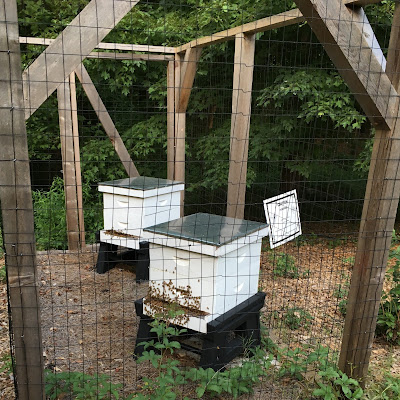Now we all know you don't move bees in the day time, but this hive is at a school on its rooftop and I only have access during school hours, so there was no choice but to move the hive in the daylight. I was worried the bees would get lost, but also fairly hopeful that all would work out.
Since I was by myself, I needed to move one box at a time. The top cover, inner cover were easy but the top box presented a challenge. The previous beekeeper had pulled one frame, probably last year, to taste the honey and had simply left the space. Bees who detest open space in a hive, hurried to fill the space with comb and honey.
I knew I would have to be very careful as I removed this box. I lifted it straight up into the air, leaving the comb behind standing on the queen excluder.
I lifted box two, queen excluder, honey comb and all at once! Then I covered it as I do all open boxes with a hive drape. In the photo below, I have already moved the bottom box and then set the second box, comb, excluder, and all on top of it.
The bottom box, having sat on the ground for all of this time, is rotting and the seams are splitting. But I didn't have a box to replace it and decided to take care of that in the spring. I don't want to disturb the bees too much this late in the season.
Next I had to move the honey box into place without destroying the upstanding lone comb. This required more dexterity than I am usually afforded, but I was slow and careful and got the job done without breaking comb - well, one tiny break. I pulled the hive drape back as I lifted the box so I could be very careful in replacing the box.
I put the rest of the hive back together - the inner cover and the top cover. Again, I had replaced the rotting bottom board with a screened bottom and a slatted rack. I leaned the bottom board over the entrance to allow the bees on the bottom board a way to climb onto the new hive. You can see the rot. I left the right side open because that was nearest to where the hive had been and I hoped they could smell the queen's pheromone better that way.
"Mama's over here....."
I was a bit worried about the large number of bees flying in the old hive location so I sat down and played on my phone for a while to see if they would find home. I could tell before I left that moving the hive wasn't going to cause too much confusion.
In the right of the above photo next to the school window, you can see what the hive was sitting on - I don't know what that stuff is - the end of a drain pipe and some other odd plastic device.
I opened the "observation hive" nuc that is there and it was filled with roaches and no bees. It makes sense. With both sides uncovered glass, it would have been way too hot and too light for bees in that box. I believe this was the observation hive's first year.
I'll see if Jeff and I can rig up a wood covering for each side. Then we can make a split from hive #1 at Spark next spring and start the observation hive up again. It would make a good teaching tool for the kids, but with the unprotected sides, it will be challenging to figure out a way to protect the bees from heat and sun.




















































